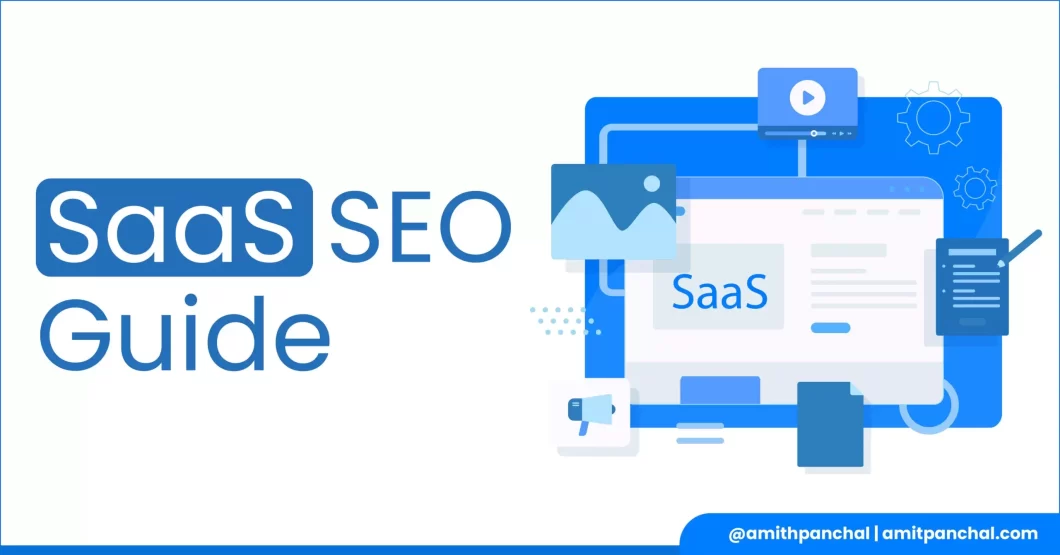In the ever-evolving digital landscape, having a strong online presence is crucial for businesses to succeed.
This is particularly true for Software-as-a-Service (SaaS) companies, where competition is fierce and customer acquisition is vital.
If you’re running a SaaS business, you may already know how important it is to attract potential customers and convert them into paying users.
Unfortunately, customer acquisition is a huge challenge for all SaaS companies right now.
This is where SEO comes in as both a cost-effective & sustainable marketing channel to help you lower customer acquisition costs and boost organic traffic and conversions on your website.
For the uninitiated, Search Engine Optimization (SEO) is a powerful tool that can help SaaS businesses stand out in search engine rankings, increase website traffic, and ultimately drive more conversions.
However, the unique characteristics of the SaaS industry require a specific approach to SEO strategy.
This comprehensive guide will explore the essential steps SaaS companies can take to optimize their website for search engines, attract more qualified leads, and grow their business.
What is SaaS SEO?
SaaS SEO refers to the process where a SaaS website and its content are optimized to attain top-ranking positions in Google SERPs for relevant keywords.
The primary objective of this strategy is to gain more organic traffic and convert it into paying customers.
To implement an effective SaaS SEO strategy, it is necessary to identify the target audience and their pain points, conduct a thorough analysis of the most suitable keywords, and develop a content strategy that caters to the needs of the target audience.
A well-executed SaaS SEO strategy can enhance organic search visibility, boost website traffic, generate leads, and establish industry authority.
How is SaaS SEO Different from Traditional SEO?
SaaS SEO is a unique branch of SEO that requires a different approach compared to traditional SEO.
The reason for this is that SaaS companies have a different target audience and require a more specialized approach to rank high in SERPs.
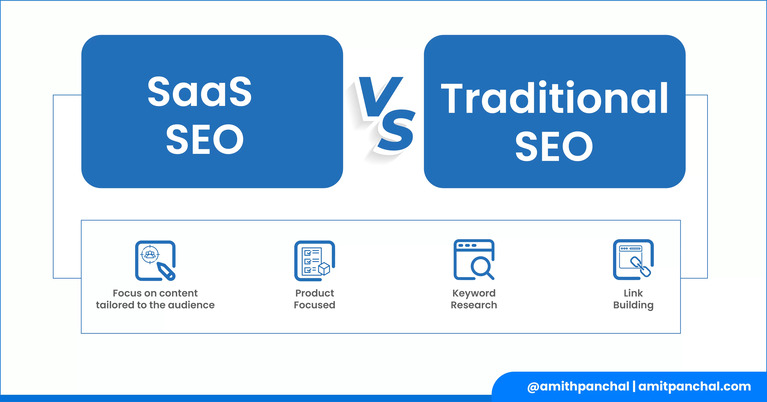
Here are some of the key differences between SaaS SEO and traditional SEO:
- Focus on content tailored to the audience — SaaS companies need to create content that is tailored to their target audience. This means that they need to understand their audience’s pain points, needs, and preferences and create content that addresses them.
- Keyword research — SaaS SEO requires more in-depth keyword research compared to traditional SEO. SaaS companies need to focus on keywords that are relevant to their product or service and their target audience’s search intent.
- Product-focused — SaaS SEO is more product-focused compared to traditional SEO. Therefore, SaaS companies need to create content that highlights the benefits of their product or service and how it can solve their audience’s problems.
- Link building — Similarly, SaaS SEO also requires a different approach to link building compared to traditional SEO. Specifically, SaaS companies need to focus on building links from relevant websites in their niche to establish their authority and credibility.
As you have just learned, SaaS SEO is quite different from traditional SEO as it requires a unique approach to rank high in SERPs.
Importance of SEO for SaaS: 3 Reasons to Invest
SEO is a crucial component of any SaaS business’s digital marketing strategy.

Here are three key reasons why investing in SEO is vital for SaaS businesses:
Increased Visibility and Credibility
With the right SEO tactics, your SaaS business can rank high in search engine results pages (SERPs), which can increase your visibility and credibility among potential customers.
When people search for a solution to their problem, they are more likely to trust and choose a business that appears at the top of the SERPs.
Lower Customer Acquisition Costs
SEO is one of the most cost-effective ways to acquire new customers for SaaS.
Unlike paid advertising, which requires ongoing investment, SEO can drive consistent traffic to your website over time, resulting in a lower customer acquisition cost (CAC).
Long-Term Sustainable Growth
SEO is a long-term strategy that can provide sustainable growth for your SaaS business.
By consistently producing high-quality content and optimizing your website for search engines, you can attract and retain customers for years to come.
Overall, investing in SaaS SEO can help you achieve your business goals, whether that’s increasing traffic, generating more leads, or boosting conversions.
By focusing on SEO as a SaaS business, you can build a strong online presence that sets you apart from your competitors and positions your SaaS business for long-term success.
Main Pillars of a Successful SaaS SEO Framework
Now that you have learned what SaaS SEO exactly is and why is it important, let’s talk about the main five pillars of a SaaS SEO framework that you need to focus on.
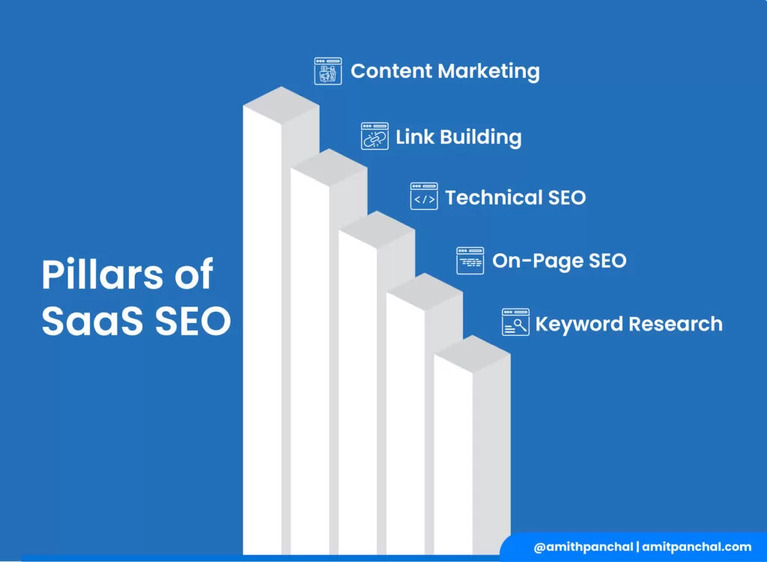
Keyword Research
Keyword research is a building stone of any successful SEO strategy.
It involves understanding the language your target audience uses when searching for your products or services and then analyzing and prioritizing the best keyword opportunities for your website.
For the uninitiated, keywords are words or phrases that people use to search for information on search engines like Google.
They are the foundation of SEO and are used by search engines to determine the relevance and importance of your website’s content.
The first step in conducting keyword research for SaaS is to identify your target audience and their pain points.
This will help you understand the language they use when searching for your products or services.
Next, you should create a list of potential keywords and analyze their search volume and competition.
Ideally, you should look for keywords with high search volume and low competition to maximize your chances of ranking on the first page of search engine results.
You can use tools like SEMrush or Keywords Everywhere to help you with this process.
Using these tools can help you identify new keyword opportunities, analyze their search volume and competition, and optimize your website’s content to improve your search engine rankings.
On-Page SEO
On-page optimization involves optimizing the content and structure of your website to make it more search engine and user-friendly. This includes optimizing page titles, headings, meta descriptions, images, and other on-page elements.
For SaaS, on-page optimization is crucial to attract more organic traffic and convert them into paying customers. Here are some tips to optimize on-page elements for SaaS:
- Keyword Research — Conduct thorough keyword research to identify the most relevant and profitable keywords for your SaaS website.
- Page Titles and Meta Descriptions — Optimize your page titles and meta descriptions to include your target keywords and entice users to click through to your website.
- Headings — Use H1 tags for page titles and H2 tags for subheadings. Include your target keywords in your headings to improve relevancy and readability.
- Content — Create high-quality, informative, and engaging content that is optimized for your target keywords.
- Images — Optimize your images by compressing them, using descriptive file names, and adding alt tags with your target keywords.
- Internal Linking — Link to relevant pages within your website to improve navigation and user experience.
Technical SEO
Technical SEO is a crucial part of a successful SaaS SEO strategy.
It involves optimizing the technical elements of your website to improve its visibility and ranking on search engines.
For the uninitiated, technical SEO is the process of optimizing the technical elements of your website to improve its visibility and ranking on search engines.
It usually involves optimizing your website’s structure, URL structure, site speed, mobile-friendliness, and more.
Technical SEO is essential for ensuring that search engines can crawl and index your website effectively, which can help improve your website’s ranking on search engine results pages (SERPs).
There are several key areas to focus on for optimizing your SaaS website for technical SEO.
- Site Speed — Ensure that your website loads quickly to improve user experience and search engine ranking.
- Mobile-Friendliness — Optimize your website for mobile devices to improve user experience and search engine ranking.
- Site Structure — Ensure that your website’s structure is easy to navigate and understand for search engines and users.
- URL Structure — Use descriptive and keyword-rich URLs to help search engines understand the content of your website.
- Schema Markup — Implement schema markup to help search engines understand the content of your website and improve your website’s visibility in search results.
Content Marketing
Content marketing basically involves creating and sharing unique, relevant, and valuable content consistently in order to attract, impress, and retain target audience.
The goal of content marketing is to drive profitable customer action by providing useful information that helps solve the audience’s problems.
For SaaS companies, content marketing is an effective way to build brand awareness, establish thought leadership, and attract potential customers.
By providing valuable content, SaaS companies can position themselves as experts in their industry and build trust with their audience.
As a SaaS SEO consultant, I have created and executed several content marketing strategies for some of my clients. And here’s the result I have achieved for one of them.
To achieve similar results for your SaaS brand, you need to get creative and apply the following SaaS content marketing best practices:
- Focus on the Customer — Create content that addresses your audience’s needs and pain points. Ideally, you should use words and phrases that resonates with your target audience.
- Use Data to Inform your Content — Use analytics tools to track your content’s performance and adjust your strategy accordingly.
- Collaborate with Influencers — Reach out and work with key influencers in your niche to expand your reach and build trust and credibility among them.
- Use a Variety of Formats — Use a mix of formats, such as blog posts, videos, and infographics, to keep your content fresh and interesting.
- Optimize for SEO — Use SEO best practices to optimize your content for search engines. Doing so will help to rank your content higher in SERPs and increase organic traffic to your SaaS website.
By following these best practices, SaaS companies can create a successful content marketing strategy that drives traffic and conversions.
Link Building
Link building is a process of acquiring hyperlinks from other websites to your site.
It is one of the most effective ways to improve your website’s search engine rankings.
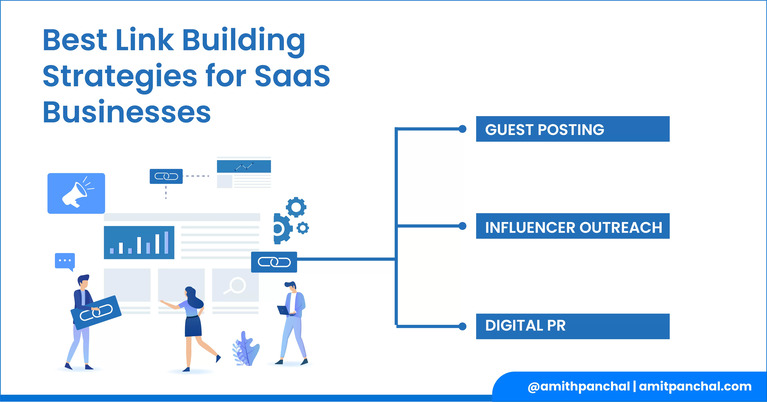
Here are the three most effective link-building strategies you can use:
1- Guest posting
Guest posting is a strategy where you write an article for another website and include a link back to your site.
It’s an effective way to build backlinks, increase your brand visibility, and establish yourself as an authority in your industry.
Here is the step-by-step process to publish guest posts and earn backlinks from relevant sites:
- Step #1 — Choose websites that are relevant to your industry and have high domain authority.
- Step #2 — Read the guest posting guidelines carefully and follow them to increase your chances of getting published.
- Step #3 — Write high-quality and informative content that provides value to the readers.
- Step #4 — Include a link back to your site in your author bio or within the content, but avoid over-optimizing your anchor text.
2 – Influencer outreach
Influencer outreach is a strategy where you reach out to influencers in your industry and ask them to promote your brand or content to their followers.
It’s an effective way to increase your brand visibility, build backlinks, and drive traffic to your site.
Here are some tips for successful influencer outreach:
- Step #1 — Identify influencers in your industry who have a large following and are relevant to your brand.
- Step #2 — Engage with them on social media by commenting on their posts, sharing their content, and building a relationship with them.
- Step #3 — Reach out to them with a personalized message and explain why your brand or content is relevant to their audience.
- Step #4 — Offer them an incentive such as a free trial or exclusive content in exchange for promoting your brand or content.
3 – Digital PR
Digital PR is the practice of building relationships with journalists, bloggers, and influencers online in order to earn media coverage and backlinks to your website.
This approach helps to increase brand awareness, improve online reputation, and drive traffic to a website through various online channels.
In terms of SaaS SEO strategy, digital PR plays a crucial role in building a strong backlink profile, which is one of the most important ranking factors.
To elaborate, Digital PR activities can help a SaaS company to earn high-quality backlinks from reputable sources, which in turn can boost the website’s authority and improve its rankings.
- Step #1 — Determine who your ideal customers are and where they spend their time online. This will help you to identify the media outlets, blogs, and influencers that are most relevant to your business.
- Step #2 — Craft a compelling pitch that will capture the attention of journalists and bloggers. Your pitch should highlight the unique value proposition of your SaaS product or service and explain why it is newsworthy.
- Step #3 — Research the journalists, bloggers, and influencers that you want to target and start building relationships with them. Follow them on social media, comment on their blog posts, and engage with them in a meaningful way.
- Step #4 — Develop high-quality content that will appeal to your target audience and provide value to the media outlets and influencers you are targeting. This could include thought leadership articles, infographics, whitepapers, or case studies.
- Step #5 — Use a mix of outreach, social media, and content syndication to distribute your content to your target audience. Reach out to your target media outlets and influencers directly, share your content on social media, and submit your content to relevant industry publications.
- Step #6 — Track the success of your digital PR efforts by monitoring your website’s backlink profile, referral traffic, and search engine rankings. Use this data to refine your strategy and identify areas for improvement.
Best Practices for SaaS SEO
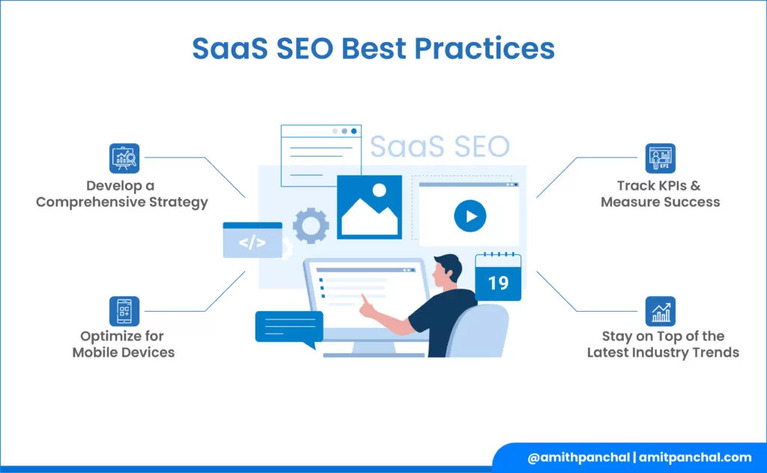
As you work to boost your SaaS website’s traffic and conversions, there are several best practices to keep in mind.
1 – Develop a Comprehensive Strategy
When it comes to SaaS SEO, developing a comprehensive strategy is essential. This means taking a holistic approach to your website’s optimization, including both on-page and off-page tactics.
Some key elements of a successful SaaS SEO strategy include:
- Keyword research to identify high-value search terms
- Optimize your SaaS website content and its meta tags for your target keywords
- Build high-quality backlinks from relevant and authoritative websites in your niche
- Produce unique, high-quality, and relevant content that satisfies your target audience’s search intent
- Engage with your potential customers on various marketing channels, especially on social media
2 – Optimize for Mobile Devices
In today’s mobile-first world, it’s more important than ever to ensure your SaaS website is optimized for mobile devices.
This means creating a responsive design that adapts to different screen sizes and loads quickly on mobile devices.
Additionally, you should also optimize your content for mobile users by using shorter paragraphs, larger fonts, and mobile-friendly navigation to name a few.
3 – Track KPIs & Measure Success
As you implement your SaaS SEO strategy, it’s important to track key performance indicators (KPIs) and measure your success.
For SaaS companies, it is essential to monitor certain metrics like website traffic, keyword rankings, backlink profiles, and conversion rates.
By monitoring the above-mentioned metrics carefully & regularly, you can easily identify opportunities for improvement and make decisions based on obtained insights to optimize your SaaS SEO strategy accordingly.
4 – Stay on Top of the Latest Industry Trends
The world of SEO is constantly evolving, and it’s important to stay up-to-date with the latest industry trends and best practices.
That’s why SaaS companies must follow industry thought leaders and publications, attend conferences and events and participate in online communities.
By staying informed, you can ensure your SaaS SEO strategy is always ahead of the curve.
Final Note
In conclusion, optimizing your SaaS website for SEO is a crucial step to increase your brand visibility and credibility, and ultimately drive more traffic and conversions.
By following the steps outlined in this guide, you can improve your website’s ranking against your competitors and increase your authority in the industry.
Remember, the most important thing is to focus on providing value to your customers through informative and engaging content, optimizing your website for user experience, and building high-quality backlinks from reputable sources.
By doing so, you can attract more qualified leads, increase conversions, and ultimately grow your SaaS business.
Share it!